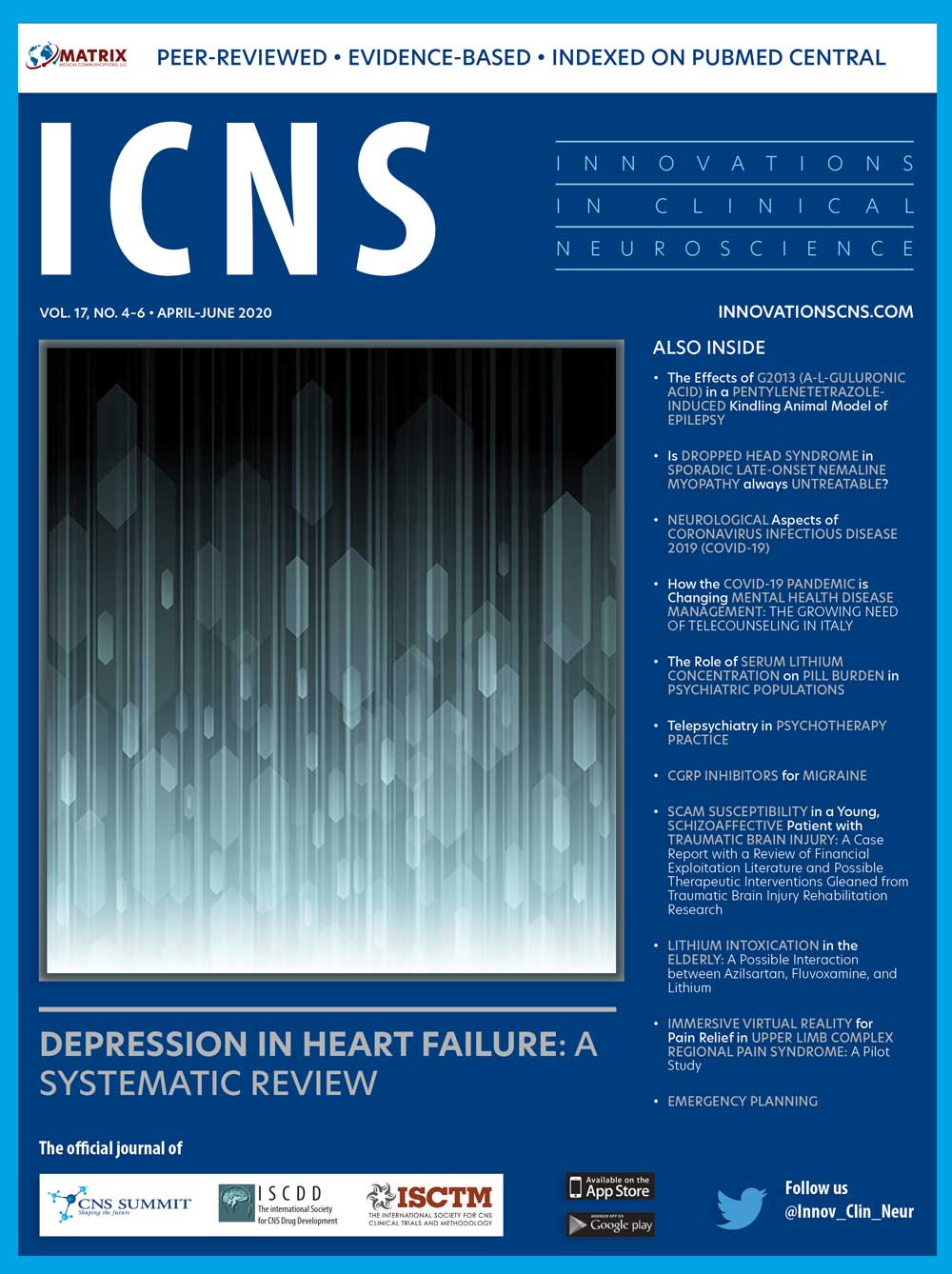 Dear Colleagues:
Dear Colleagues:
Welcome to the April–June 2020 edition of Innovations in Clinical Neuroscience (ICNS).
For 2020’s second quarterly issue of ICNS, we start with original research by Azizi et al titled, “The Epileptogenesis Property of G2013 (α-L-Guluronic Acid) in Pentylenetetrazole-Induced Kindling Model.” Here, Azizi et al evaluate the therapeutic efficacy and epileptogenesis potential of G2013 (α-L-Guluronic acid) has on seizures and epilepsy. This is achieved by monitoring stages of the neurological condition in animal models. Afterward, the researchers used data collected from the animal models’ brain tissue to determine differences between the group given G2013 and the controls.
Next, Dr. Nitin Butala reports recent findings regarding neurological effects of a novel coronavirus, COVID-19, and discusses the potential impact these findings could have on patient outcomes in his review, “Neurological Aspects of Corona Virus Infectious Disease 2019 (COVID-19).” Dr. Butala gathers recent data from Wuhan, China, to highlight fatality risks in adult patients who contracted the COVID-19, as well as potential neurological symptoms, such as headache, dizziness, impaired consciousness, ataxia, acute cerebrovascular disease, epilepsy, peripheral nervous system (PNS) symptoms, and musculoskeletal symptoms. The study concludes with Dr. Butala sharing COVID-19-related recommendations and guidelines from neurologic disease-specific organization websites.
Following this, in their commentary, Calabro and Dr. De Luca discuss the importance of utilizing telecounseling as a means for treating mental health disorders during the COVID-19 pandemic in their commentary. Stay-at-home orders, quarantine, community containment, and social distancing have altered the lives of many people all over the world, causing feelings of isolation and stress, as well as fear of contamination and death.
Next, Chehovich et al sought to determine the association between lithium serum concentrations and medication burden in patients with psychiatric illness. The authors analyzed the related retrospective data of 38 inpatients and 192 individual serum lithium concentrations to find a potential correlation. Researchers discovered found targeting a lower serum lithium concentration might reduce toxicity risk and avoid an increase in the number of psychiatric medications an individual is prescribed.
Following that is this issue’s Psychotherapy Rounds column. In “Telepsychiatry in Psychotherapy Practice,” Cowan at el offer solutions to potential obstacles, such as privacy issues, health information security, and maintaining a bond, clinicians might encounter while transitioning from in-person practice to telehealth. With the use of three descriptive vignettes, the authors explore the concerns of different patients and how clinicians responded to ensure the safety and security of all involved.
Next, in the review titled, “Depression in Heart Failure: A Systematic Review,” IsHak et al determine the devices used to measure depression in heart failure (HF) and examine the impact of various treatment interventions on depression in HF using data from 27 previously published studies from 1988 to 2018. The studies involving depression and HF were located through the review of the PubMed and PsycINFO databases via keywords “depres*” and “heart failure.”
Following this is another review titled, “CGRP Inhibitors for Migraine.” Here, Drs. Lippmann and Mohanty explain why migraine headaches remain a great medical concern that adversely affect many people, as well as how the pathophysiology of migraines is associated with calcitonin gene-related peptide (CGRP) pathways. The authors believe CGRP inhibitor drugs can provide enhanced efficiency for patients seeking relief when suffering from head-related pain.
Next, in a case report titled, “Scam Susceptibility in a Young, Schizoaffective Patient with Traumatic Brain Injury: A Case Report with a Review of Financial Exploitation Literature and Possible Therapeutic Interventions Gleaned from Traumatic Brain Injury Rehabilitation Research,” Drs. McCormick and Simberlund review the case of a 27-year-old man with schizoaffective disorder whose severe traumatic brain injury (TBI) led to the loss of $200,000. The authors explored TBI rehabilitation strategies to better comprehend the underpinnings of the patient’s scam susceptibility and prevent financial exploitation in the future.
Following is Dr. Takahiko Nagamine’s case report titled, “Lithium Intoxication in the Elderly: A Possible Interaction between Azilsartan, Fluvoxamine, and Lithium.” Here, Dr. Nagamine explains that because of its narrow therapeutic index, lithium can lead to intoxication, using the case of an 82-year-old male patient that had a 25-year history of bipolar affective disorder and hypertension who began to show symptoms of lithium intoxication after being prescribed medications to treat the above conditions.
Next, in “Immersive Virtual Reality for Pain Relief in Upper Limb Complex Regional Pain Syndrome: A Pilot Study,” Ta et al evaluate the effects of therapeutic immersive virtual reality (VR) on pain in upper limb complex regional pain syndrome (CRPS) in eight volunteer participants from outpatient rehabilitation services with CRPS, as there is little data regarding VR treating chronic pain conditions. The pilot study lasted for 10 sessions, with feedback and pre- and post-session pain scale measurements (Short Form McGill Pain Questionnaire, Visual Analog Scale, and Wong-Baker FACES) collected. Of all the participants, four experienced improvement of pain and limb function.
Finally, we wrap up the issue with the Risk Management column, titled “Emergency Planning,” by Ann L. McNary. Here, Ms. McNary provides the steps necessary when creating an effective emergency plan for business practices. These directions aim to minimize damages and preserve the safety of all involved.
As always, we hope you enjoy this issue of ICNS, and we look forward to receiving your feedback and submissions.
Sincerely
Amir Kalali, MD
Editor, Innovations in Clinical Neuroscience





